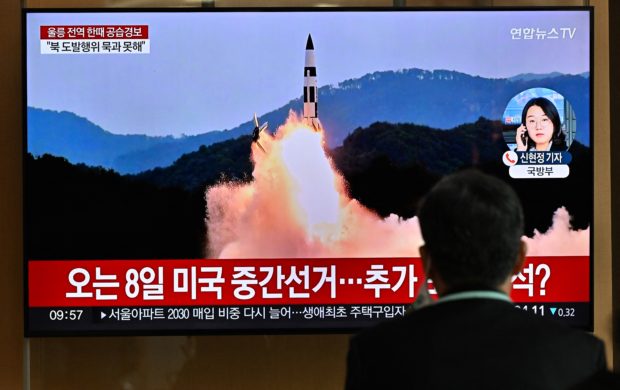North Korea fires more than 10 missiles, one close to South Korea

A man watches a television screen showing a news broadcast with file footage of a North Korean missile test, at a railway station in Seoul on November 2, 2022. – South Korea on November 2 told residents on the island of Ulleungdo off its east coast to evacuate to bunkers after North Korea fired three short range ballistic missiles. (Photo by JUNG YEON-JE / AFP)
Seoul, South Korea — North Korea fired more than 10 missiles Wednesday, including one that landed close to South Korea’s waters that President Yoon Suk-yeol said was “effectively a territorial invasion.”
One short-range ballistic missile crossed the Northern Limit Line, the de facto maritime border between the two countries, prompting a rare warning for residents on the island of Ulleungdo to seek shelter in bunkers.
The military said it was the “first time since the peninsula was divided” at the end of the Korean War hostilities in 1953 that a North Korean missile had landed so close to the South’s territorial waters.
“President Yoon pointed out today that North Korea’s provocation is an effective territorial invasion by a missile that crossed the Northern Limit Line for the first time since the division,” his office said in a statement.
The missile that was closest to South Korea landed in waters just 57 kilometers (35 miles) east of the South Korean mainland, the military said.
Article continues after this advertisementThe military released a statement describing the missile launch near South Korean territorial waters as “very rare and intolerable.”
Article continues after this advertisement“Our military vowed to respond firmly to this (provocation),” it added.
Soon after, the South Korean military said it had fired three air-to-ground missiles near the spot on the maritime border where the North Korean one had landed.
An air raid warning was issued for Ulleungdo after the North Korean missile launch. The alert was flashed on national television and told residents to “evacuate to the nearest underground shelter.”
The South Korean military’s Joint Chiefs of Staff initially said it detected the launch of three short range ballistic missiles.
But it later announced North Korea had fired more than 10 missiles “of various types today towards the east and west.”
Yoon Suk-yeol called a meeting of the National Security Council over the launches, ordering “swift and stern measures so that North Korea’s provocations pay a clear price.”
Japan also confirmed North Korean missile launches, with Prime Minister Fumio Kishida telling reporters he planned to call a “national security meeting as soon as possible.”
Vigilant Storm
Pyongyang’s latest test firing came as Seoul and Washington staged their largest-ever joint air drills, dubbed “Vigilant Storm” and which involve hundreds of warplanes from both sides.
Pak Jong Chon, a high-ranking official in North Korea, said the drills were aggressive and provocative, according to a report in state media Wednesday.
READ: North Korea fires two missiles into sea as South Korea wraps up drills
Pak said the name of the exercises harks back to Operation Desert Storm, the US-led military assault on Iraq in 1990-1991 after it invaded Kuwait.
“If the US and South Korea attempt to use armed forces against the (Democratic People’s Republic of Korea) without any fear, the special means of the DPRK’s armed forces will carry out their strategic mission without delay,” he said.
“The US and South Korea will have to face a terrible case and pay the most horrible price in history.”
Close to South Korea
North Korea’s missile launches on Wednesday were appeared to be “the most aggressive and threatening armed demonstration against the South since 2010,” Cheong Seong-chang, a researcher at the Sejong Institute, told AFP.
“It is now a dangerous and unstable situation that could lead to armed conflicts,” he added.
In March 2010, a North Korean submarine torpedoed the South Korean naval vessel Cheonan, killing 46 sailors including 16 who were on their mandatory military service.
In November the same year, the North shelled a South Korean border island, killing two marines – both of them young conscripts.
READ: North Korea says it practiced firing cruise missiles able to carry nuclear weapons
Wednesday’s missile tests follow a recent blitz of launches, including what the North said were tactical nuke drills.
Washington and Seoul have repeatedly warned the launches could culminate in another nuclear test – which would be Pyongyang’s seventh.
“As far as I can remember, North Korea has never made such a provocation when South Korea and the US were holding their joint drills,” Park Won-gon, a professor at Ewha University, told AFP.
“Pyongyang seems to have completed its most powerful deterrent. This is a serious threat. The North also seems confident in their nuclear capabilities.”
RELATED STORY
North Korea fires missile over Japan, stopping trains and sparking warning message